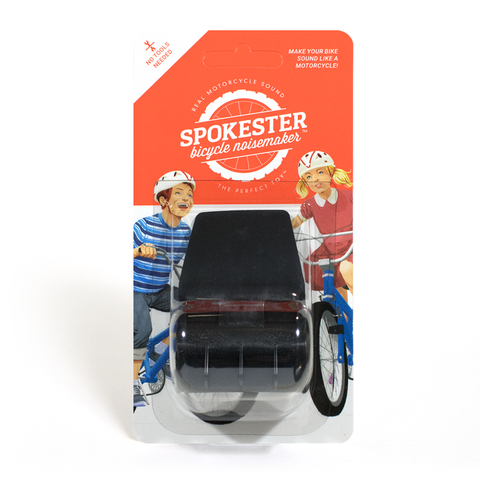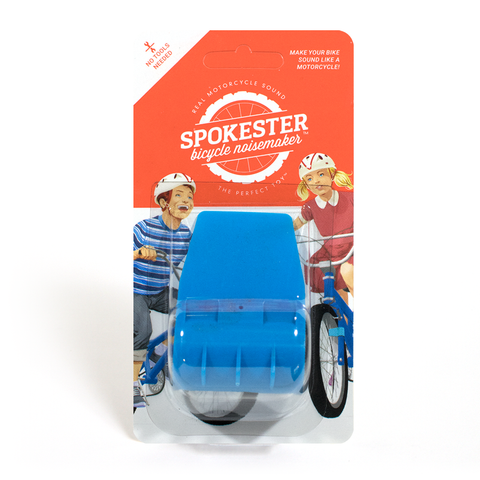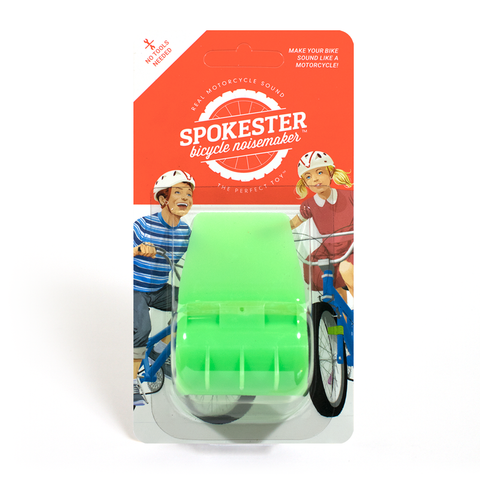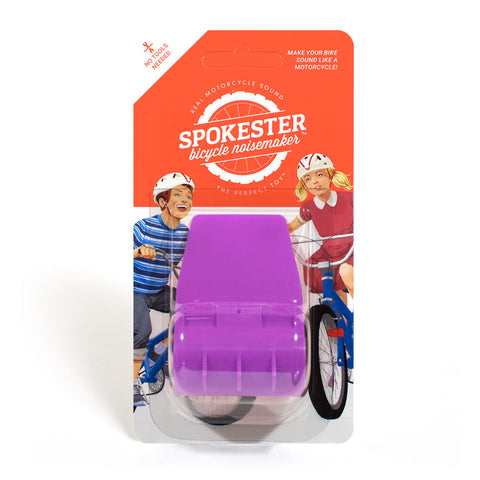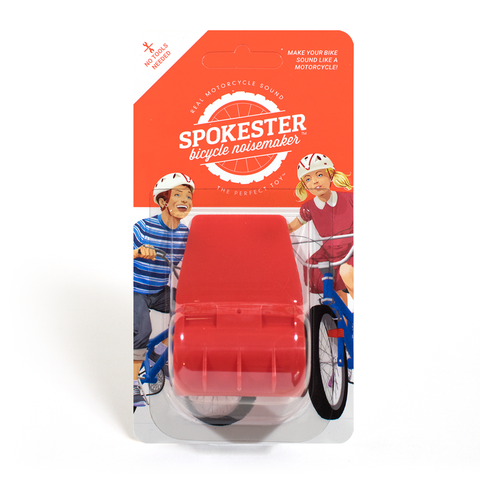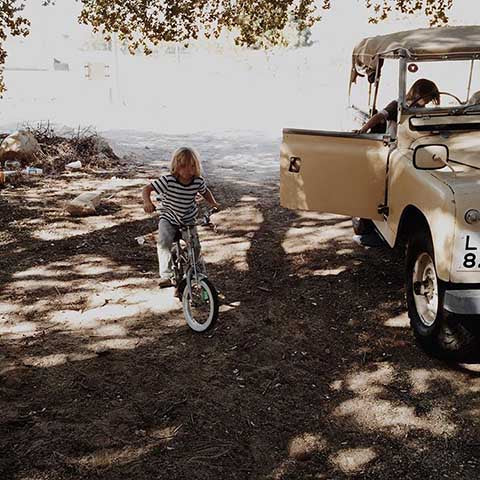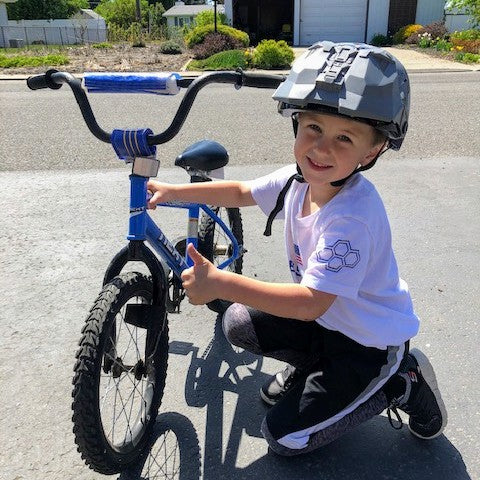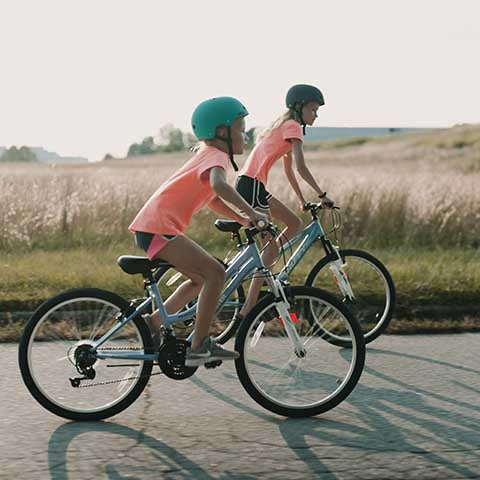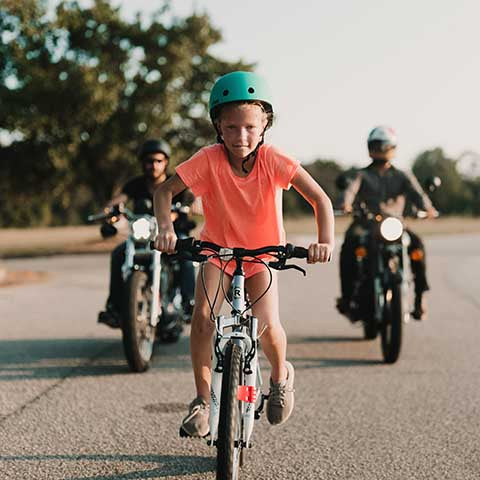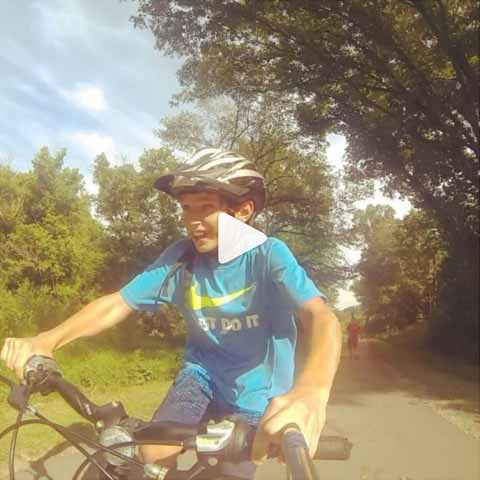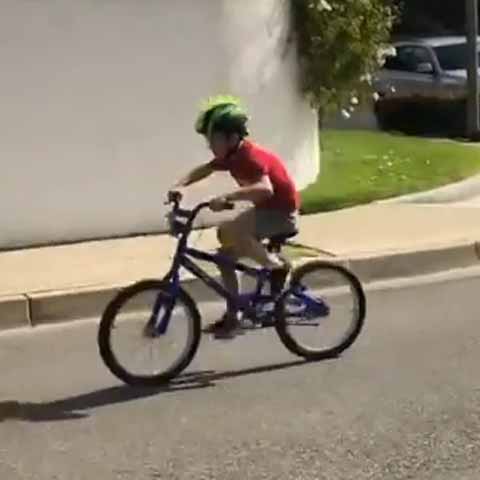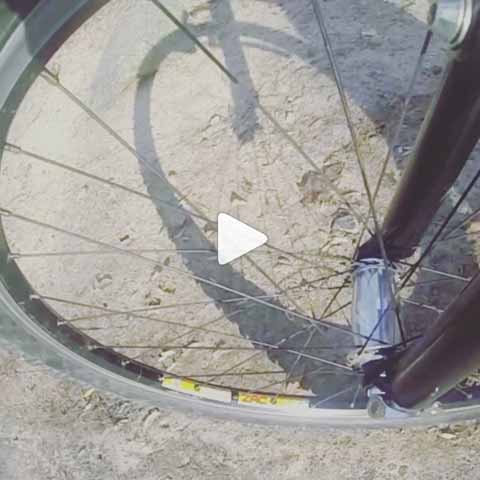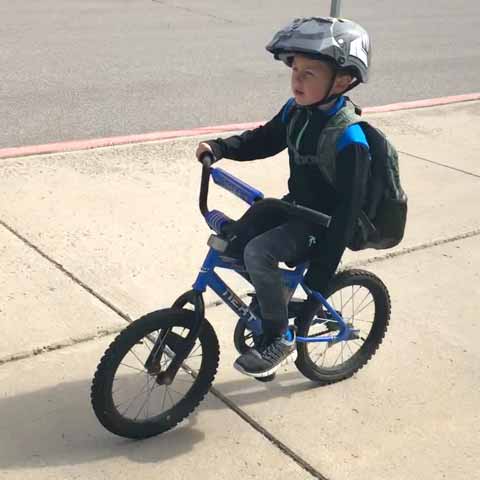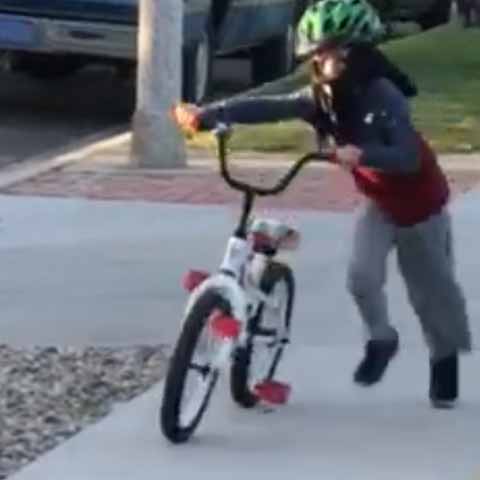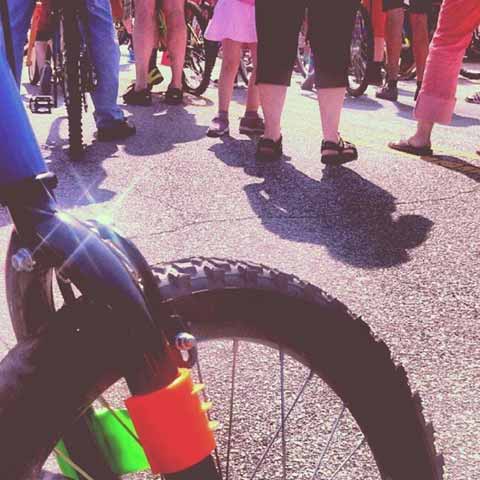The Ultimate Bicycle Glossary for Parents of Young Riders
Wait, you don't know the difference between a caliper and a cantilever? Have you been living under a rock?
Don't worry, we're just kidding. Bicycling parts and terms can start to meld together after a while. When your child first hops on a bike, you're probably not going to reference Google that often. But, once he or she gets a little older and cycling options start expanding, your cycling vocabulary may very well need to follow suit.
That's why we've put together this list of 40—that's right, forty—bicycle terms that will make you the most knowledgeable mom or dad on the block. Our goal is to give you a topline understanding of a bike's anatomy so that you can talk the talk as you're walking the walk up and down the department store bike aisle. We're not engineers and odds are you aren't either, so we'll keep the technical jargon to a minimum. Note: If you are an engineer, enjoy this little break from shop speak.
Is there more to say about these? Oh yeah, each one could have its own Wikipedia page (and some do). Are there even more terms out there than this? Sure, but unless you're planning to build junior's bike from scratch in the garage, this ought to be more than enough at the moment.
Now, let's get smarter…
- Balance Bike
- What's even better than a bike with pedals? How about a bike without pedals! At least that's one school of thought when it comes to teaching your kids how to ride. As the theory goes, learning balance and counter-steering before pedaling shortens the overall learning curve. If done in the opposite order using training wheels, kids have to re-learn how to pedal while also figuring out how to control their bodies. Sound reasonable? If so, here's some more information on kids' balance bikes.
- Bicycle Trailer
- Because we're not running a rickshaw business, we're referring to children's bicycle trailers here. These guys haul your precious cargo behind you when you're out on the road or even doing some light trail riding. Depending on the model, some can even convert into strollers, freeing up valuable storage space around the ole homestead. Additional deets on trailer cycles can be found here.
- BMX Bike
- BMX stands for "bicycle motocross." Relax, not all BMXers involve two-wheel tearing around dirt berms as a prelude to the motorized version. These bikes fall into three main categories: race, freestyle, and jump. Depending on which strikes your kid's fancy, you'd be looking for a BMX designed for a specific purpose such as speed or stunts. We devote an entire article to kids' BMX bikes, so click on through if yours are all about ramps, grinds, or tailwhips.
- Brake Cable
- Those thin, bendy things extending the length of your bike from the hand brakes to the wheels? Those are the brake cables. Each one is actually made up of two separate cables, an inner and an outer. The inner consists of a bunch of stainless steel strands wound together, and the outer is a steel weave with a hollow casing for the inner cable and the protective housing you see attached to your frame. The force you generate by pulling the brake lever is transmitted through tension on the inner cable and compression to the outer housing. In other words, mechanical magic.
- Brake Pad
- Just like the ones your auto mechanic warns you about every time you go in for a simple oil change, brake pads are the parts applying the stopping force to your bike. They work by creating friction between the pad and the wheel's rim or a disc on the wheel's hub. With rim brakes, it's fairly easy to see when the original pad grooves, or "teeth," are history. Disc brakes require a little more effort to check for wear because of their setup. Whichever your kid has, make sure you look at them regularly, especially on bikes that see hard and fast riding or a lot of dirt and mud.
- Caliper
- Calipers are a type of rim-brake system mounted to a single point above the wheel. When the brake's hand levers are pulled, the cable tension causes two arms to clamp around the wheel's rim, which slows due to friction with the arms' brake pads. These are mostly used on bikes with thinner tires since they're less effective the wider they get. So, if you're a mountain biker, feel free to disregard this entry.
- Cantilever
- Cantilevers are another common rim-brake system that differs in a key way from calipers. Instead of one centered pivot point, their arms are attached to separate points on each side of the wheel. Since the brake's inner cable is attached to one of the arms and the outer to the other, pulling on the hand levers causes the two arms to clamp together on the rim. This system is common on hybrid bikes, BMX race bikes, and entry-level mountain bikes. If you ever want to impress your kid in front of the sales rep, sprinkle this term around liberally.
- Chain
- Bike pedals are attached to the sprocket, which is that thing that looks like a gear in between the pedals. The energy you generate by turning the sprocket is transferred to the rear wheel through the bike's chain, propelling you forward. Chains are usually made from carbon or alloy steel and can have different lengths and widths depending on whether you're on a single-speed or multi-speed bike. They're also greasy, which your kids will quickly discover the first time they need to reset one after it pops off due to aggressive curb jumping.
- Clip-In Pedals
- Also known as "clip-in pedals," clipless pedals improve the connection between your foot and… wait for it… the bike's pedals. These are paired with specially-made shoes that are stiffer than your run-of-the-mill Payless variety. Together, they improve comfort, prevent slipping, and maximize pedaling power for serious road or off-road riders. It should be a while before junior comes knocking for these guys, so no reason to dive into the surprisingly-deep pool of cycling-specific footwear just yet. Here's a deep dive on clipless pedals.
- Coaster Brakes
- Who doesn't love a good skid down the hill by throwing things in reverse? Coaster (or "foot" or "back-pedal") brakes allow you to do just this. They get their name from letting the bike "coast" without moving the pedals, something that wasn't possible before their introduction just before the 20th Century. They also act as the bike's stopping mechanism when rotated in reverse. The harder you pedal backwards, the harder you brake. These basically disappear once you move on to specialized bikes, and you can learn why by reading about the differences between coaster and hand brakes here.
- Cogset
- File this under Things You'll Probably Never Need to Fully Understand, but we'll touch on it anyway so that you at least know what your local bike repair guru is talking about when the time comes. A cogset is the group of sprockets—sometimes referred to as gears—attached to the rear wheel hub. They come in freewheel or cassette versions, each connecting the sprocket setup to the hub in slightly different ways. If you're at the point of needing to understand the finer details of either of these, you're probably not even reading this in the first place.
- Crankset
- To get a bike to move, the rider presses down on the pedals, which turns the sprocket to set off a mechanical chain reaction. The middlemen in this equation are the cranks, or the bars on each side of the bike connecting said pedals to said sprocket. This collective system driving the rotational motion of the bike's drivetrain is called the crankset, or "chainset" by our British friends. Pretty cut and dry no matter which side of the Atlantic you're on.
- Derailleur
- Not to sound like a GEICO commercial, but derailleurs derail, it's what they do. When a rider shifts gears while pedaling, tension changes on a cable attached to a chain guide. This derails, guides, slips—call it what you will—the chain from one sprocket to another on the front chain rings or the rear cogset. Slick name for a slick part.
- Disc Brakes
- Disc brakes are a type of hand-braking system that have become widely popular in recent years, especially among serious road and mountain bikers. Instead of acting on the wheel's rim like traditional rim brakes, these guys squeeze a metal rotor on the wheel's hub just like what you'd find on a car. Mechanical disc brakes operate using a cable similar to rim brakes, whereas hydraulic disc brakes trigger brake fluid that pushes against the brake pads. You can read more about the ins and outs of disc brakes here. And with that, we're done with the word "brakes" for a while.
- Drivetrain
- Drivetrain is a collective term for the bicycle parts responsible for transferring power from you to your ride. This includes a bunch of the other stuff in this list, including the pedals, crankset, cogset, sprocket, and derailleur. If it's not actively involved in driving the bike forward, it's not part of the drivetrain.
- Frame
- A bike's frame is its foundation. There are literally more than a dozen different kinds of frames out there built for different styles of riding. The most common design is known as the diamond frame and consists of a main triangle ahead of a rear triangle. A frameset also includes other key components such as the fork, or the two arms connecting the front wheel to the frame and handlebar stem. Frames can be made out of carbon fiber, carbon steel, chromoly steel, aluminum, titanium, and possibly other hard stuff we don't even know about. The various tubes that make up the frame all have their own names, and if you're that curious about what those are, may we direct you to the bottomless fountain of knowledge that is the Google.
- Gears
- On a multi-speed bike, different gears let riders apply different amounts of pressure to the pedals. As resistance increases, the distance the bike moves forward with each rotation also increases. Depending on your kid's style of bike, he or she may have only a handful of gears to more than 20. The different combination of chain locations on the various sprockets on the front rings and rear cogset determine the gear ratio. Lower ratios mean easier pedaling and vice versa. The takeaway? Agonizing over drivetrain geometry for your tyke's first multi-gear bike shouldn't be a high priority.
- Hand Brakes
- Bikes that stop through the use of hand brakes use a freewheel hub. This hub allows the rear wheel to turn even if the pedals are stationary and, unlike coaster brakes, does not activate the brake if the rider pedals backwards. Levers on either side of the handlebars are connected to a set of rim or disc brakes on the front and rear tires using a cable that controls braking power. As we explain elsewhere, the vast majority of adult bikes use hand brakes, so conventional wisdom says to get your little ones comfortable with them asap.
- Handlebars
- Handlebars once again prove that seemingly straightforward bike parts really rarely are. Seriously, there are, like, 15 different kinds of bars out there from flat to cruiser to aero to… plenty of others. Each one is good for something specific, whether it's better leverage for pedaling distances, climbing steep terrain, tucking in close for speed, or otherwise. You'll most likely be dealing with either flat or riser bars (which may as well be flats). If your kid develops into a dedicated pavement pounder, you may also be shopping for those vertical, curved drop bars you see on road bikes.
- Kickstand
- Like motorcycles, bicycle kickstands are those thin little steel or aluminum bars on the bottom of the frame that flip down so your bike stays upright when not in use. Most serious cyclists don't want them because they add weight, reduce aerodynamics, and can even get in the way if you're riding through the bush. Until then, it's not a bad idea for your kid to have one since the alternative is repeatedly dropping the bike on grass, dirt, concrete, and other awesome surfaces for abrasion.
- Mountain Bike
- Mountain bike, occasionally shortened to "MTB," is a general term for any two-wheeler built for the backcountry. But, given they can be ridden on pretty much any surface, they've become highly popular among kids and are often their first multi-speed ride. Some brands even make models with features specifically for children to ease the transition. Check out our dedicated mountain-biking article for the full monty on mounties.
- Pedal
- We're just going to assume 99.99% of our reading audience knows that bike pedals are what you push down to make the bike go. For those who don't, we just told you. So, to fill this space with something useful, let's go ahead and revert back to somehow-still-useful Latin. Pedal's root word, ped—or pod in Greek—means "foot." Hence, words like biped, moped, tripod, podiatrist, and yes, pedal, all have to do with this part of your body. Thanks again, prep school.
- Pegs
- Pegs are short metal pieces attached to either side of the axle on the front and/or rear wheel. Meant for flatland and street stunts, they're almost exclusive to freestyle BMX bikes. Riders place their feet on the pegs to center their weight over the wheel, which makes the bike easier to control when performing certain tricks. You may or may not want to ease into these things.
- Quick Release Skewer
- Those road and mountain bikes you see without front wheels on the back of the SUV ahead of you? Don't worry, they didn't just fall off in transit (hopefully), they were probably taken off using a quick release skewer. This is a rod that goes through the hollow axle and then threaded onto a special nut. A built-in lever makes it easy to loosen and remove the wheel from the bike's fork without the use of tools. Pretty neat, huh? Just make sure you secure your ride well before walking away. It's not just easy for you, it's easy for the bad guys as well.
- Reflector
- Had your mind blown lately? Well, get ready. The purpose of a bike reflector is to reflect light. Sarcasm aside, these things actually involve more science than you might think at first. Micro-prisms, spherical beads, light scatter, retroreflection, yada yada yada… we're not going to get into that. All you need to know is that reflectors on the frame, pedals, and wheels all help drivers see you at night when their headlights bounce off of them. So, if your kids are out there on dawn patrol or like to turn in after sunset, make sure they've got a few of these.
- Rim Brakes
- Once your little ones have graduated from single-speed coasters but before they move on to highly-specialized bikes, rim brakes will be your best friend. Hand-braking systems have traditionally used rim brakes, which clamp around the wheel's rim when the hand levers are activated to stop the bicycle. The debate between rim versus disc brakes is ongoing, but know that these are more than adequate for your youngster until he or she decides to up the biking-lifestyle ante.
- Road Bike
- Road bikes are multi-speeders built specifically for riding on hard, flat surfaces (like roads). Their frames, braking systems, and tires are all geared toward speed and comfort over long distances. This means that it's not a great idea for your kiddies to use their roadsters in the backwoods or on vert ramps. In addition to making sure they learn the fundamentals of biking, it's also a good idea to incorporate the rules of the road before turning them loose in traffic. Check out our kids' road bikes post to learn more about this side of the sport.
- Rotor
- Unless your kiddo's heading down the freestyle BMX path, you're not going to run into this. For those who are, in fact, fortunate enough to be in this position, a rotor (yet another term with multiple alternatives such as "Gyro" or "detangler") is a key component for certain tricks. It allows the handlebars and front wheel to turn completely around without tangling the rear brake cable. If you're wondering about the front cable, this can be rerouted through the stem (the piece connecting the handlebars to the frame) to achieve the same effect. For more on rotors, check out our article BMX Briefing: Pegs and Rotors.
- Saddle
- While the rest of the free world simply calls it a "seat," we'll go with saddle here since it's technically the term for that thing you sit on while riding. Most saddles use a hard shell covered with some form of gel or foam padding, which itself is then covered with an outer casing such as leather, vinyl, or spandex. Saddles come in all shapes and sizes tailored to the style of riding your bike is built for. Unless your kid has lower-body medical issues or has become an ultra-serious cycler, the manufacturer-provided seat saddle should be just fine.
- Shifter
- Like so many other aptly-named components in this list, shifters do exactly what you think they do: shift gears. Located around the handlebars, shifters operate cables leading to the derailleur or internal hub mechanism that controls a bike's multi-speed gear system. Traditional shifters are activated using your thumb, though some models now offer other options that are integrated with the handlebar grips or hand-brake levers. Whichever they use, it won't be long before they get the hang of it.
- Single-Speed Bike
- Single-speed refers to a bike that has only one gear ratio. Beach cruisers, BMXs, classic commuters, and, of course, bikes for young children all fall into this category. The beauty is in their simplicity. Although multiple gears let you climb hills more easily and go faster on straightaways, single-speeds are typically lighter, cheaper, and easier to maintain than multi-speeds. We'd bet the farm that this will be your kid's first pedal bike.
- Spoke
- Those little rods connecting the wheel's rim to its hub are called spokes. Under tension to support the bike's rim, spokes are usually made of some form of steel, although titanium, aluminum, and carbon fiber are also used. Most bikes have between 28 and 36, with speed racers opting for fewer to reduce weight and drag. Freestyle BMXers, on the other hand, sometimes need as many as 48 given all of the jumping and pounding they put their rides through. Generally speaking, you won't need to worry about these in the early stages of your little buddy's foray into biking, if ever.
- Sprocket
- A sprocket is a wheel with teeth that meshes with the bike chain to transfer power from the rider to the wheel. On single-speed bikes, the chain passes over one sprocket on the rear wheel hub. Multi-speed bikes feature multiple sprockets and a derailleur to shift the chain between them. If you're thinking to yourself, "Wait, isn't that a gear?", you're not alone. Call it that if you'd like, but for the record sprockets engage a chain or similar device while gears interact with one another directly. Keep that in mind next time it comes up on Jeopardy!.
- Suspension
- Suspension systems act as shock absorbers and improve traction by keeping one or both wheels in contact with the ground as much as possible over rough terrain. As a result, they're really only found on mountain bikes. "Hardtails" are bikes with front-only suspension, which takes the form of telescoping tubes along the fork above the wheel hub. "Dual (or full) suspension" bikes also have a rear system. Not to be the horse with no name, bikes without suspension are called "rigid."
- Tire
- Those dark, bouncy, rubber things on the outside of the wheel are the bike's tires. Just like car tires, these have different shapes and treads for different surfaces and styles of riding. When you inflate your tire, you're actually blowing up a separate tube within the outer rubber. Tire PSI, or pound per square inch, is the standard measure of inflation and should vary depending on the terrain (e.g., lower PSI for better grip on dirt, higher PSI for faster speed on pavement, etc.). Airless tires that use foam instead of an inflatable tube do exist, but chances are slim to none that you'll be dealing with these, so just keep the bike pump handy.
- Trailer Cycle
- What happens when you cross a kid's bike with a bicycle built for two? Well, based on the name of this entry, you get a trailer cycle. Instead of using a front wheel, trailer cycles attach to the seat posts of adult bikes in a way that allows them to pivot when turning. This gives toddlers a taste of what it's like to pedal and balance without the risk of tipping over that comes with a standalone bike. We talk more about trailer cycles in a separate post.
- Training Wheels
- Also called "stabilisers" in Europe (no typo, just British), training wheels are small wheels attached to the rear axle that prevent little riders from tipping over. The idea here is that they allow young kids to get the hang of pedaling, steering, and braking before having to do all three while also trying to balance. There's been a lot of noise from the balance-bike community about how bad these are for teaching kids how to ride. Don't sweat it. More than likely you yourself learned using training wheels without a traumatic transition to two wheels, so you teach however you want to teach.
- Tread
- Tread is the part of a tire that comes in contact with the ground. Most have grooved patterns snaking their way throughout to improve traction and tire performance in different conditions. For instance, knobby tread helps mountain bikers and dirt BMXers ride through loose soil and gravel. Road-bike tires use smoother tread that better conveys water in wet conditions. Regardless of style, tread eventually wears down and the tire needs to be either re-treaded or replaced entirely. Youngsters probably won't be keeping a very close eye on this, so spot check their rubber once in a while.
- Tricycle
- Tricycles, or "trikes" for short, are the three-wheeled cousins of bicycles ("bi" = 2, "tri" = 3… so clever). Because of the extra wheel, tricycles tend to be more stable, but balance is still required when cornering. The most common trike style features one wheel in front and two in the back, otherwise known as the "delta" configuration. When two are in the front and one's in the back, it's called a "tadpole." We have no idea why, either. Recumbent trikes (those low ones with the person's legs way out in front) also exist, but that's a whole different level of biking and probably one you won't need to worry about at this stage.
- Wheel
- The old adage "Don't reinvent the wheel" doesn't seem to apply in bike land. Bicycle manufacturers are constantly coming up with new designs, materials, and part configurations to make wheels stronger, lighter, and easier to maintain. Just about every part from the axle to the rim is customizable depending on your riding style. Unless you plan on building your own ride, sit tight with the factory model until Billy or Bonny really starts taking cycling seriously.
← Older post Newer post →
